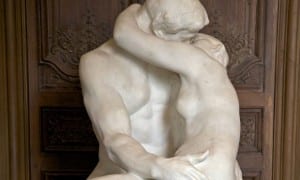Tino Seghal’s Kiss from Gratza (2015) for guardian.com
I was fortunate enough to experience a performance in a gallery during my reading week. At the Henry Moore Institute in Leeds there has been ongoing exhibition The Events Sculpture which “presents nine sculptures that are events” (Henry Moore Institute, 2014). The exhibition is asking “how transitory sculptures can be written into art history” (Henry Moore Institute, 2014). The exhibit consisted of nine sculptures which began as an event and then were integrated into the gallery space from 3rd February 2015. Some of the work included have been performed before, for example Slant Board by Simone Forti was the first piece in the exhibition but was actually performed in 1961 in Yoko Ono’s loft in New York. Not all the work is new but it is given the opportunity to be performed by different people and to new audiences. Not only can you engage with the work in the galleries but Agnieszka Gratza, a writer and art critic, has been commissioned to publish a text response to the sculptures on the Henry Moore Institute website.
One of the nine pieces I was able to experience was Tino Sehgal’s Kiss. Unfortunately I missed the first performance, however from 3rd February it moved into the gallery and has been reperformed there since, and will continue to be performed there until the exhibition ends.
Upon visiting The Event Sculpture exhibition, although I was aware of the exhibit, I was not aware Kiss was being performed daily and so when the couple began their routine I was taken by surprise. I found that the performance was easy to engage with. It was fascinating watching the movements of the two dancers. They were able to create intimacy and sexual chemistry with “No sighing, gasping, heavy breathing, or any other sounds of pleasure” (Gratza, 2015) but with their movements between each other. I found that the silence was very powerful and potentially it is something I would like to include in my performance. The silence increased the intimacy of the piece and I felt as if the performance was private, it felt like I was watching the private moments of the couple, the moments usually unseen. The room they performed in was white and bare, with the exception of the wooden ramp used in Slant Board at the rear and Roman Signer’s Chair in the entrance. The empty room allowed the couple to be the centre of attention and you felt drawn to them as you watched them. It was definitely worth taking some time to experience the work.
It was wonderful experience to see a piece of performance in a gallery as it has helped to develop some ideas of my own for my performance. It has shown me that simplicity can be far more effective than a busy piece of work.
Works Cited:
Gratza, A. (2015) Event Sculpture 7: Tino Sehgal, ‘Kiss’ (2002). [online] Leeds: Henry Moore Institute. Available from http://www.henry-moore.org/hmi/online-papers/the-event-sculpture/event-sculpture-7-tino-sehgal [Accessed 2 February 2015].
Henry Moore Institute (2014) The Events Sculpture 10 November 2014 – 8 March 2015. Leeds: Henry Moore Institute.

Leave a Reply